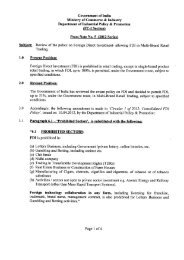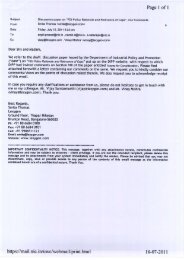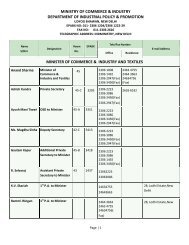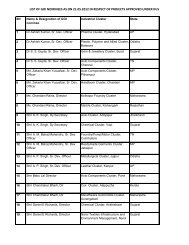fdi in india and its growth linkages - Department Of Industrial Policy ...
fdi in india and its growth linkages - Department Of Industrial Policy ...
fdi in india and its growth linkages - Department Of Industrial Policy ...
You also want an ePaper? Increase the reach of your titles
YUMPU automatically turns print PDFs into web optimized ePapers that Google loves.
exist<strong>in</strong>g <strong>in</strong>frastructure, (b) exploit<strong>in</strong>g natural locational <strong>and</strong> cultural aff<strong>in</strong>ities, such as proximity to Taiwan <strong>and</strong> Hong<br />
Kong, <strong>and</strong> (c) unbundl<strong>in</strong>g <strong>in</strong>frastructure development from the development of the SEZ, ensured that <strong>in</strong>vestments were<br />
market-oriented, reduced the risk of str<strong>and</strong>ed <strong>in</strong>vestments as a result of special locational privileges <strong>and</strong> ensured that the<br />
<strong>growth</strong> was more reflective of Ch<strong>in</strong>a’s underly<strong>in</strong>g comparative advantage. This market-orientation, coupled with Ch<strong>in</strong>a’s<br />
high sav<strong>in</strong>gs <strong>and</strong> <strong>in</strong>vestment rate, has made it the success it is today.<br />
4.10.8 Indian SEZs<br />
India also had similar models of EPZs <strong>and</strong> EOUs. These were located at various places <strong>in</strong>clud<strong>in</strong>g Coch<strong>in</strong>, Falta, K<strong>and</strong>la,<br />
Chennai, NOIDA, Santa Cruz, Visakhapatnam <strong>and</strong> Surat. But these eight zones failed to achieve their export targets.<br />
Thus, a policy was <strong>in</strong>troduced on April 1, 2000 to set up Special Economic Zones <strong>in</strong> the country with a view to<br />
provid<strong>in</strong>g an <strong>in</strong>ternationally competitive <strong>and</strong> hassle-free environment for exports. This was supplemented by the<br />
comprehensive SEZ Act of 2005. Un<strong>its</strong> may be set up <strong>in</strong> an SEZ for manufacture of goods <strong>and</strong> render<strong>in</strong>g of services.<br />
All the import/export operations of the SEZ un<strong>its</strong> will be on a self-certification basis. The un<strong>its</strong> <strong>in</strong> the Zone have to be<br />
net foreign exchange earners but they shall not be subjected to any pre-determ<strong>in</strong>ed value addition or m<strong>in</strong>imum export<br />
performance requirements. Sales <strong>in</strong> the Domestic Tariff Area by SEZ un<strong>its</strong> shall be subject to payment of full customs<br />
duty <strong>and</strong> import policy <strong>in</strong> force. Further, offshore bank<strong>in</strong>g un<strong>its</strong> may be set up <strong>in</strong> the SEZs.<br />
The policy provides for sett<strong>in</strong>g up of SEZs <strong>in</strong> the public, private, or jo<strong>in</strong>t sector, or by state governments. It was also<br />
envisaged that some of the exist<strong>in</strong>g Export Process<strong>in</strong>g Zones would be converted <strong>in</strong>to Special Economic Zones.<br />
Accord<strong>in</strong>gly, the government has converted Export Process<strong>in</strong>g Zones located at K<strong>and</strong>la <strong>and</strong> Surat (Gujarat), Coch<strong>in</strong><br />
(Kerala), Santa Cruz (Mumbai-Maharashtra), Falta (West Bengal), Madras (Tamil Nadu), Visakhapatnam (Andhra<br />
Pradesh) <strong>and</strong> Noida (Uttar Pradesh) <strong>in</strong>to Special Economic Zones. In addition, three new Special Economic Zones<br />
approved for establishment at Indore (Madhya Pradesh), Manikanchan – Salt Lake (Kolkata) <strong>and</strong> Jaipur (Rajasthan)<br />
have commenced operations.<br />
4.10.9 Characteristics of the Indian SEZ Model<br />
The dist<strong>in</strong>ct characteristics of the Indian SEZ model are described below:<br />
SPECIAL ECONOMIC ZONES (SEZS) AND FDI IN INDIA<br />
� International experiences show that the government has largely developed special economic zones <strong>and</strong> has <strong>in</strong>vested<br />
the necessary funds to create zone <strong>in</strong>frastructure.<br />
� As an extension, the government has also taken the pr<strong>in</strong>cipal responsibility for market<strong>in</strong>g these zones <strong>in</strong>ternationally.<br />
Unlike this, the primary thrust of the Indian SEZ model is to facilitate ‘private sector-led’ SEZs. This has opened<br />
up possibilities for develop<strong>in</strong>g SEZs <strong>in</strong> the private sector <strong>and</strong> jo<strong>in</strong>t sector.<br />
� Keep<strong>in</strong>g <strong>in</strong> view the learn<strong>in</strong>gs from other countries, the Indian SEZ model also envisages a m<strong>in</strong>imum size of 1,000<br />
hectares for all greenfield SEZs. As highlighted earlier, a m<strong>in</strong>imum critical mass or size is necessary to create the<br />
desired economic multiplier. The comb<strong>in</strong>ed utilised area under all EPZs <strong>and</strong> FTZs <strong>in</strong> India is 2,100 acres, i.e., less<br />
than 1,000 hectares, which is the m<strong>in</strong>imum size stipulated for greenfield SEZs. The simultaneous conversion of<br />
exist<strong>in</strong>g EPZs <strong>and</strong> FTZs <strong>in</strong>to SEZs provides an opportunity to test <strong>and</strong> f<strong>in</strong>e-tune the SEZ policy before it is applied<br />
to greenfield SEZs.<br />
� The experience of comparable countries shows that decisions such as location selection, number of SEZs to be<br />
promoted <strong>and</strong> the focus for <strong>in</strong>vestment attraction have largely been <strong>in</strong>fluenced by the national government. In the<br />
Indian SEZ model, states are be<strong>in</strong>g encouraged to take these choices, while the central government largely focuses<br />
on policy-mak<strong>in</strong>g <strong>and</strong> facilitation. This has resulted <strong>in</strong> a number of proposals from states for develop<strong>in</strong>g SEZs. S<strong>in</strong>ce<br />
much of the fund<strong>in</strong>g for SEZs is envisaged through the private sector/ banks, the soundness of the bus<strong>in</strong>ess model,<br />
competitive differentiation <strong>and</strong> market forces would be key determ<strong>in</strong>ants of the bankability of these projects.<br />
43












